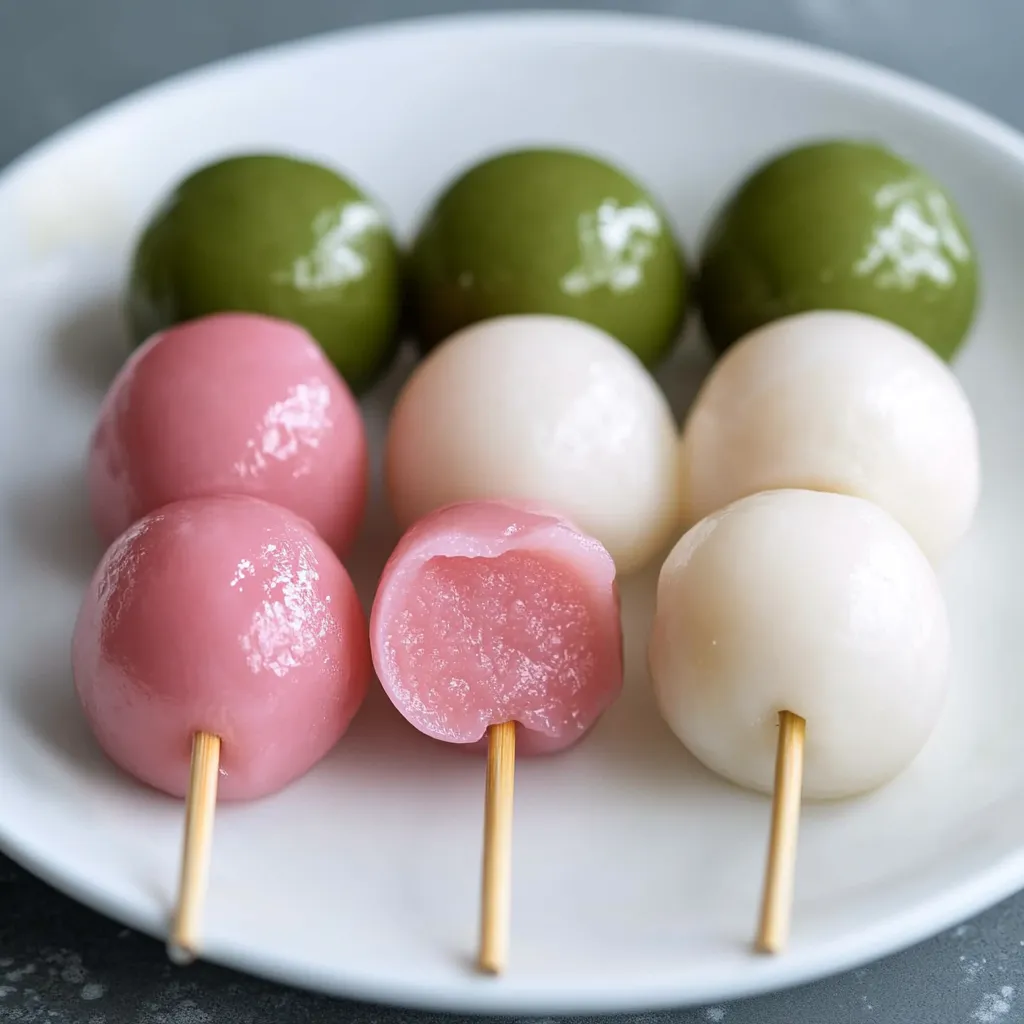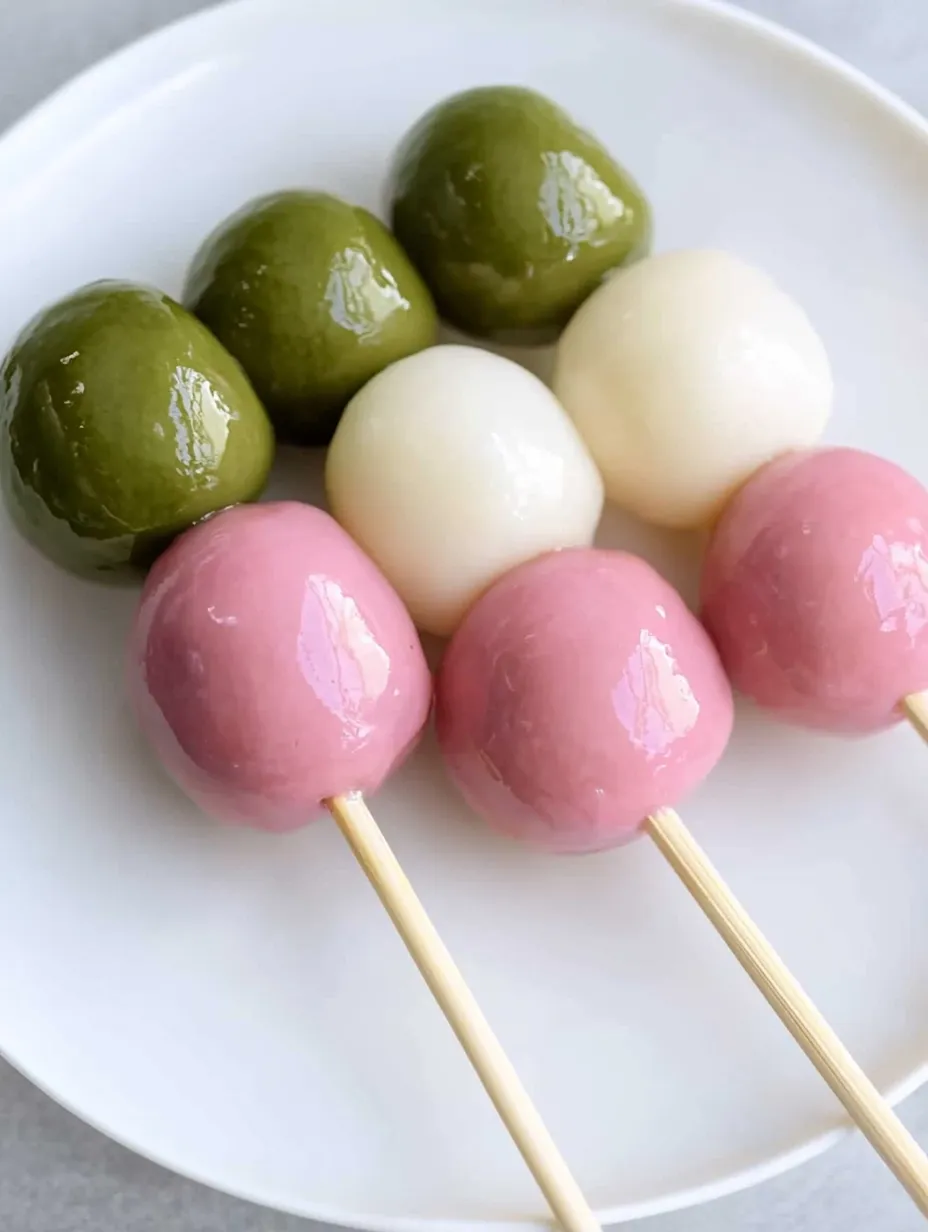 Pin it
Pin it
Dango is a delightful Japanese sweet that signals the start of spring and brings back so many memories of cherry blossoms and outdoor picnics. With simple ingredients, these colorful chewy rice dumplings come together for a treat that looks as good as it tastes.
The first time I made dango for my niece’s birthday she could not believe I made them at home. Now she requests them every time we get together for a family picnic.
Ingredients
- Joshinko rice flour: This is non-glutinous rice flour that gives dango its essential structure and clean bite. Look for brands that are a bright white color with a fine grind
- Shiratamako sweet glutinous rice flour: This special rice flour provides dango with the classic chewy texture. The best quality will have a pearly shine and scatter easily when poured
- Powdered sugar: This makes dango sweeter and softer. Choose a fine powdered sugar for easy blending and a smooth dough
- Hot water: The temperature helps bind everything together for easier mixing. Always use freshly boiled water and let it cool just enough so it is hot but not scalding
- Matcha powder: Adds gentle green tea flavor and color. Select ceremonial grade for best aroma and mild taste
- Pink food coloring: Gives the dango its beautiful cherry blossom color. Gel-based colorings yield the brightest and most even hue
Step-by-Step Instructions
- Soak the Skewers:
- Submerge 12 bamboo skewers in water for at least 20 minutes. This step prevents the skewers from splitting and keeps the dough balls from sticking.
- Mix the Dry Ingredients:
- Combine the joshinko rice flour and shiratamako in a large bowl. Add powdered sugar if you want an extra touch of sweetness. Whisk them well so the flours blend evenly.
- Make the Dough:
- Pour in the hot water while stirring with a spoon or chopstick. As the mixture begins to clump, knead it by hand until it becomes a soft smooth dough with a play-dough like texture. If the dough feels dry add a teaspoon or two more water. If too soft add a little more rice flour.
- Color the Dough:
- Divide the dough evenly into three portions. In one portion knead in a drop of pink food coloring until it becomes pastel pink. For the second portion mix matcha powder with a touch of water to form a paste then knead it into the dough until smooth. Leave the third portion white.
- Shape the Balls:
- Take a kitchen scale and weigh out each piece of dough into roughly 20 gram balls. Repeat until you have about 36 balls total. Keep your hands slightly damp to avoid sticking when rolling.
- Cook the Dango:
- Bring a pot of water to a rapid boil. Drop in the white dango balls first. When they float to the top cook them for another two minutes then immediately transfer to a bowl of ice water. Repeat the same steps for pink and then green dango so the colors stay vibrant.
- Skewer the Dango:
- Thread three balls onto each skewer in the order green white pink. This sequence honors the seasonal reflections in Japanese tradition.
 Pin it
Pin it
My favorite ingredient has to be matcha since it gives a delicate bitterness which balances the sweetness from the sugar. When my mom and I made dango together for the first time the kitchen was full of laughter and dango dough sticking to our fingers.
Storage Tips
Store leftover dango in an airtight container in the refrigerator. Be sure to place a damp paper towel inside to keep them from drying out. I like to give the sticks a quick dip in hot water before serving if they feel too firm from the fridge. Avoid freezing as this can change the chewy texture.
Ingredient Substitutions
If joshinko rice flour is unavailable you can try using mochiko but the texture will be a little softer. You can use natural beet or raspberry juice instead of food coloring for a more subtle pink shade. For extra sweetness roll each dango stick in a coating of kinako roasted soybean flour or drizzle with a little sweetened condensed milk.
Serving Suggestions
Dango is wonderful served as is but you can elevate it by brushing on a sweet soy glaze or topping with red bean paste. I enjoy serving dango with a pot of freshly brewed green tea at hanami flower viewing parties or as a sweet finish to any Japanese meal.
Cultural Historical Context
Dango has been enjoyed in Japan for hundreds of years especially during cherry blossom season. Hanami dango with their three distinctive colors are a festive treat often packed for outdoor celebrations. The color order of green white pink is both traditional and meaningful in Japanese culture.
Frequently Asked Questions
- → What flours are needed for dango?
Dango uses a blend of non-glutinous rice flour (joshinko) and glutinous rice flour (shiratamako) for its signature chewiness.
- → How do you color dango balls?
Mix in matcha paste for green and pink food coloring for pink balls while leaving some dough uncolored for the white ones.
- → How can you tell dango is cooked?
The balls float to the surface while boiling; continue cooking for 2 more minutes before chilling in ice water.
- → Why soak the bamboo skewers first?
Pre-soaking skewers prevents the dango from sticking and makes threading the balls easier after cooking.
- → What toppings go well with dango?
Dango can be enjoyed plain or paired with sweet soy glaze, red bean paste, or additional matcha paste as toppings.
- → Can dango dough be softened?
Replacing water with silken tofu in the dough can make the texture even softer and more tender.
